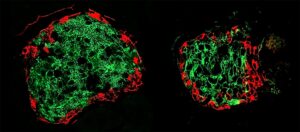To begin photosynthesis, the plants send anterograde signals to themselves. The signal activates the plastid-encoded bacterial-type RNA polymerase (PEP) to transcribe plastid photosynthesis genes. However, the identity of the anterograde signal still needs to be understood. The main challenge has been distinguishing regulators from the plethora of necessary components for plastid transcription and other essential chloroplast functions, such as photosynthesis.
Scientists at UC Riverside have now decoded those previously opaque signals.
The nucleus encodes hundreds of proteins containing building blocks for the smaller organelles. The main challenge was to determine which ones are the signal to them to trigger photosynthesis.
Previously, scientists identified specific proteins in plant nuclei that are activated by light, triggering photosynthesis. In this study, scientists identified four proteins that are part of that reaction. These proteins send a signal that transforms small organs into chloroplasts, which generate growth-fueling sugars.
UCR botany professor Meng Chen said, “The conductors of the symphony are proteins in the nucleus called photoreceptors that respond to light. We showed in this paper that both red and blue light-sensitive photoreceptors initiate the symphony. They activate genes that encode the building blocks of photosynthesis.”
The particular circumstance, in this case, is that both local (the nucleus) and remote musicians conduct the symphony in two separate “rooms” within the cell. As a result, the conductors (photoreceptors), which are only present in the nucleus, must convey some messages to the musicians who are situated far away. The four recently identified proteins from the nucleus to the chloroplasts regulate this final stage.
Chen said, “Currently, a lot of research describes communication from organelles back to the nucleus. If something is wrong with the organelles, they’ll send signals to the nucleus “headquarters.” Much less is known about the activity-regulating signals sent from the nucleus to the organelles.”
“The nucleus may control the expression of mitochondrial and chloroplast genes similarly. So, the principles we learn from the nucleus-to-chloroplast communication pathway might further our understanding of how the nucleus regulates mitochondrial genes and their dysfunction in cancer.”
“The significance of understanding how photosynthesis is controlled has applications beyond disease research. Human settlements on another planet would likely require indoor farming and creating a light scheme to increase yields in that environment. Even more immediately, climate change is posing challenges for crop growers on this planet.”
Journal Reference:
- Hwang, Y., Han, S., Yoo, C.Y. et al. Anterograde signaling controls plastid transcription via sigma factors separately from nuclear photosynthesis genes. Nat Commun 13, 7440 (2022). DOI: 10.1038/s41467-022-35080-0













